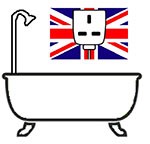One of the challenges of the modern world has been how to standardise electrical connections so that products such as appliances can be made for a wider market. While this is far from completely achieved, we do have a more or less consistent approach in Europe and a set of safety standards that apply across the whole continent. Though there are still about eight variations on the design of plugs and sockets!
The UK has its own “Wiring Regulations”. British Standard BS 7671 Requirements for Electrical Installations. IET Wiring Regulations is a national standard for electrical installation and the safety of electrical wiring in domestic, commercial, industrial, and other buildings. The standard has changed over the years with increasing international standardisation rendering some of its earlier provisions unnecessary.
The 17th Edition rationalised the previously overly cautious approach to sockets in bathrooms by accepting that it was quite safe to install laundry equipment in rooms containing a fixed bath or shower as long as they were far enough away from potential splashing. Modern products have water ingress ratings of IPX4 and, with increased use of RCDs, it is common in many countries to see laundry equipment in bathrooms rather than kitchens.
However, in the UK appliances in bathrooms can only be connected via a fused connection unit. This means that if the householder wants to put their washing machine in the bathroom, they have to remove the non-rewirable plug checked in a factory and rewire it themselves.
BS7671 requires modern plug sockets to be RCD protected so if an appliance were plugged into such a socket it would have this level of protection. Not only is this safer for the consumer than removing the plug, it also means that a service engineer can just unplug the product rather than having to disconnect the supply at the consumer unit to carry out servicing.
It is therefore proposed that the UK requirements be amended to allow appliances to be connected in Zone 2 (more than 0.6m from the bath or shower) using ordinary plug sockets.

